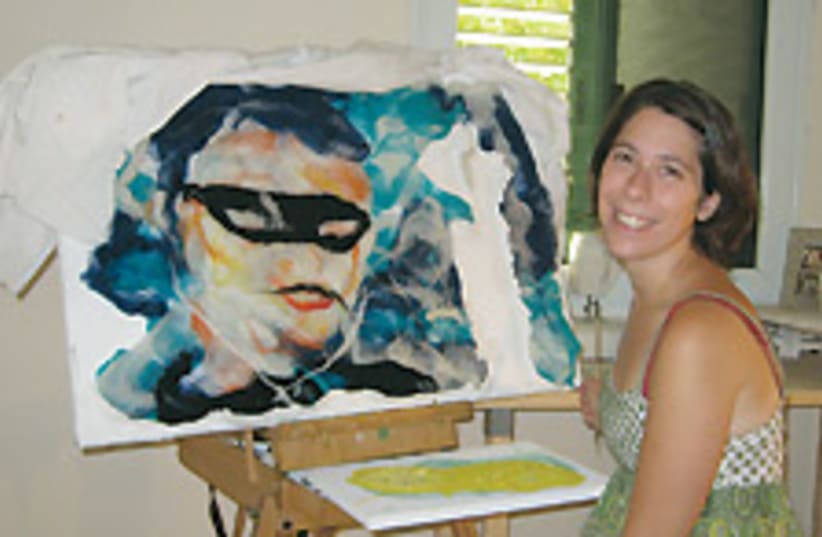Art that blossoms in the desert
English immigrant Hannah Rendell draws inspiration for her work from a settlement outside Beersheba.
Hannah Rendell, a recent olah from England and an up-and-coming artist now living in the Lehavim suburb on the outskirts of Beersheba, is all about the meeting of humans and nature. She uses her art to highlight man's ability to bring life to the desert while also respecting his natural environment.
Her current three-piece series, on show at Gecko Café in Beersheba, serves as an introduction to this theme and a commentary on her journey to Israel, while exploring new textures and materials.
Rendell studied art at Bournemouth Art Institute on the south coast of England, and then got an art degree from Manchester Metropolitan University. She earned a post-graduate certificate of education from Goldsmith College in London and taught for four years in public schools and a religious Jewish school. After exhbiting on her home turf, Rendell had to leave most of her artwork behind when she made aliya, giving most away and selling what she could.
Her style derives partly from French sculptor and painter Niki de Saint-Phalle's colorful creations, producing fun, vivid, child-like images while still maintaining an aura of detailed sophistication. Additionally, the 27-year-old artist lacks a sense of taste and smell, and has thus developed a heightened sense of touch which helps stimulate brilliant 3-D creations.
In her work Catatonia, bright hues of reds and yellows capture Rendell's energy and excitement over embarking on a new project. Manipulating a man's felt-wool face over 15 times distorted her original design to such an extent that she used its catatonic state as a muse for the piece's title.
The central figures of Removed from Love, the second piece in the sequence, are adapted from Marc Chagall's Lovers in Green. The floating, dreamy images move across a deep aqua sky, appropriately capturing the spiritual move of aliya to Israel. Man in the Desert, the third piece, relays the physical transfer to Israel.
While the first two canvases experiment with unfamiliar mediums, Rendell's comfort with Man allows her to focus entirely on creating her own subject, a man who resembles Zorro and signifies the man behind the desert.
Despite the fact that Rendell designed and painted with specific topics in mind, she encourages her audience to develop its own relationship with the works. "With art, people either love it or hate it, which is exactly what I want. I have had a lot more positive experience than I expected because the natural way of people is to criticize. I am not scared of that. I want people to give my work the time to talk about it."
To her, art is about telling a story.
Cafes, much like the one on Rehov Smilasky that houses her work, promote discussion. They are potential hot spots for a growing community to converge over a cup of coffee and analyze the pieces in a relaxed atmosphere. She is "not trying to play God by claiming to be the Ultimate Creator," but rather she is employing her role as the artist to "bring what is already there to the attention of others."
AS AN artist, Rendell chose to bring her work to Beersheba, a thriving industrial center, because she feels it necessary that the desert flourish not only in science and technology, but in culture as well. The societal trends of Jerusalem and Tel Aviv may provide better opportunities in the long run, but to her, desert lands mean Israel. There she finds inspiration.
"People say that they don't feel inspired, but if your art is your business, you need to find the will to be inspired. You cannot wait for inspiration to find you. There has always been something missing for me in my work. I would start a project but feel that something was absent. Here, because of Israel, everything is starting to feel like it is coming together. To be producing work here feels so right."
Though Rendell sits on a design for many months, she finishes the creative process in matter of days. Her materials, which vary from man-made synthetic beads and plaster to raw-cut stone, oil and wax, can work together nicely, but she does not expect them to produce a precise result. "You can never transfer the exact image from your head onto the canvas, so either you spend time battling with getting it perfect, which is impossible, or you relent and give yourself over to the technical process of creation," an exercise she finds much more rewarding.
The London native is currently expanding her collection to include a series of sculptures that also explore the desert-bloom phenomenon. After gathering old, dead trees, Rendell will decorate them with strands of beads and other man-made objects. She is continuing her examination of various textiles through a line of uniquely designed handbags as well. She plans on opening 10-week-long art classes for the adults of Lehavim in the fall.
Rendell can readily access inspiration, yet she knows that she will face many other challenges before becoming a success. Right now, she is devoting her energies to closing the language gap. Despite five months in ulpan, her current state of Hebrew prohibits her from conversing comfortably with natives, a prerequisite for networking in the larger artistic field.
Would she love to become an international success? Of course, but never to the extent that she no longer personally creates the art. "My pure enjoyment comes from getting my hands dirty and becoming involved in the craftsmanship."
if(catID != 151){
var cont = `Take Israel home with the new
Jerusalem Post Store
Shop now >>
`;
document.getElementById("linkPremium").innerHTML = cont;
var divWithLink = document.getElementById("premium-link");
if(divWithLink !== null && divWithLink !== 'undefined')
{
divWithLink.style.border = "solid 1px #cb0f3e";
divWithLink.style.textAlign = "center";
divWithLink.style.marginBottom = "40px";
divWithLink.style.marginTop = "40px";
divWithLink.style.width = "728px";
divWithLink.style.backgroundColor = "#3c4860";
divWithLink.style.color = "#ffffff";
}
}
(function (v, i){
});

